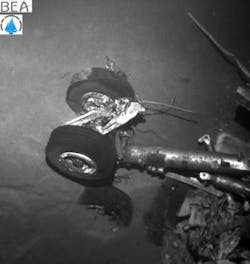Vision system aboard unmanned underwater vehicle captures images of Air France wreckage
A search team led by the Woods Hole Oceanographic Institution (WHOI; Falmouth, MA, USA) has located the wreckage of Air France Flight 447 some 3,900 meters, or nearly 2.5 miles, below the surface of the Atlantic Ocean off Brazil’s northeastern coast. The team used three autonomous underwater vehicles (AUVs) with sidescan sonar and downward-facing, Pike F-421B FireWire cameras from Allied Vision Technologies (Stadtroda, Germany) to map the area and image the wreckage.
The team left the port of Suape, Brazil, aboard the vessel Alucia on March 22, arriving at the search site on March 25. After one week of searching, one of the mission’s three AUVs, the REMUS 6000s, detected debris on the seafloor. A second vehicle was dispatched to the area for more detailed sonar mapping and photographic imaging. The images it brought back were relayed to BEA, the French air safety investigation authority, which identified the wreckage as the Airbus A330. All three REMUS vehicles are currently mapping the area to get a comprehensive view of the accident site.
Flight 447, a scheduled commercial flight from Rio de Jeneiro to Paris, crashed into the Atlantic Ocean on June 1, 2009, carrying 216 passengers and 12 crew members. WHOI led the search under the direction of the BEA, Bureau d’Enquêtes et d’Analyses.
The search mission was the fourth attempt to locate the aircraft. WHOI also participated in the third search effort. WHOI Senior Engineer Mike Purcell was the chief of sea search operations for the mission.
Images included photos of the fuselage, engine, and landing gear and a sonar image of the crash area. Investigators plan to examine the wreckage in detail and to continue to search for the plane’s flight recorders
The REMUS 6000 AUV was designed by WHOI under a cooperative program involving the US Naval Oceanographic Office and the Office of Naval Research, and built by Hydroid (Pocasset, MA, USA). Two of the vehicles are owned by the Waitt Institute and operated by WHOI; the third is owned and operated by Leibniz Institute for Marine Sciences IFM-GEOMAR (Kiel, Germany). These vehicles are designed to operate in depths up to 6,000 meters (19,685 feet or 3.73 miles).
SOURCE: WHOI
--Posted by Vision Systems Design
